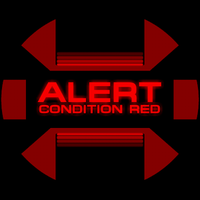No edit summary |
No edit summary |
||
| Line 1: | Line 1: | ||
[[File:redalert.png|thumb|200px]] | [[File:{{#setmainimage:redalert.png}}|thumb|200px]] | ||
Alert condition codes allow for standard procedures to be followed in specific conditions. | Alert condition codes allow for standard procedures to be followed in specific conditions. | ||
Revision as of 19:02, 29 October 2017

Alert condition codes allow for standard procedures to be followed in specific conditions.
Colored Conditions
There are three standard conditions named after colors - these also correspond to the color of alert notification lights throughout a location.
- Condition Red / Red Alert corresponds to Condition 1
- Condition Blue / Temporal Alert corresponds to Condition 2
- Condition Yellow / Yellow Alert corresponds to Condition 3
- Condition Green / Normal Operations corresponds to Condition 0
- Grey Mode corresponds to Condition 7
Numbered Conditions
| Number | Name | Description |
|---|---|---|
| 0 | Condition Green |
|
| 1 | Tactical Alert Red Alert General Quarters Battle Stations |
|
| 2 | Temporal Alert Condition Blue |
|
| 3 | Yellow Alert |
|
| 4 | Environmental Alert |
|
| 5 | Decompression Alert Collision Alert |
|
| 6 | Security Alert |
|
| 6A | Security Readiness Heightened Security |
|
| 7 | Grey Mode |
|
| 8 | Medical Quarantine |
|
| Theta | Theta Protocol |
|
Security Alert / Security Readiness
These conditions go hand in hand. However, a full security alert is not meant to be a prolonged status except in the most dire situations. As such Condition 6A is designed as a long-term status of heightened security with as little disruption to station life as possible. Many times one condition is a prelude to the other and department heads as well as command crews should maintain the ability to transition smoothly from one condition to the other.
A full Security Alert is reserved for an imminent or active threat to security, while Security Readiness is reserved to prepare for possible security threats.
Theta Protocol
A protocol developed for the Temporal Reconciliations to signal that a temporal catastrophe is imminent and must be responded to with as many resources as possible. This protocol has been used only once, and was invoked to give additional resources to governments in combating an Infinity Wave while a team was dispatched to the waves epicenter. The operation was successful and proved both the need for and the acceptable use of Theta Protocol.